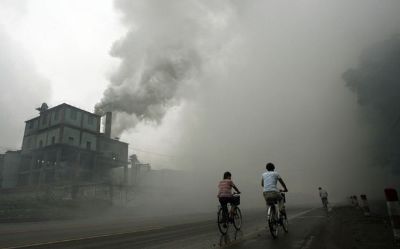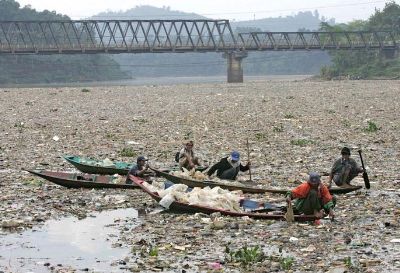by Larry
July, 2014Dirty China
Despite such evidence of stresses on the way, the surge of mainland China's gross national product in recent decades, roughly three times our own in the same years, seems as irrepressible as molten lava hurtling toward the sea. Surely there are limits to its big bang expansion, yet they may not be reached for another half-century or so. Could there eventually be war with the U.S., a series of anarchic rebellions, a terrible plague, regime change, catastrophic earthquakes, or other disasters? Absolutely. Yet the main cost of such extraordinary development and a swelling population (for China's census, notwithstanding the one-child policy, is now estimated to total 1.37 billion) is similar to a frequent chore in most households, cleaning up the messy dishes that accompany any complicated culinary creations. Just as was true in western nations during the 19th to 20th Centuries' heyday of unregulated tycoons and industry, China's land, air, and water are becoming filthy to a grand degree. Thanks to unfettered mining, agriculture, and factory operations involving poisonous materials such as cadmium and arsenic, roughly one acre in five of China's farmland is deemed toxic even by the government's conservative admissions. Inevitably, the noxious chemicals are getting into food supplies. Official reports concede that up to half of rice in some regions contains high levels of dangerous contaminants. Certain rural areas, so-called "cancer villages," have significant overall carcinogenic characteristics. Last year, only 4% of mainland Chinese cities met government standards for air quality. In the capitol, Beijing, acceptable air quality levels occurred less than half the days of the year. Visibility is often only a couple blocks, and people routinely wear masks to be able to breathe without too much health damage. In some of the country's industrial northern cities, conditions are worse still.
In order to make it appear that China had no serious air challenges, traffic was halted and factories or power plants shut down prior to the 2008 Olympics, so Beijing citizens saw how good air quality could be. Yet things rapidly returned to normal afterward. In the U.S., air quality is regarded as good if the Air Quality Index (AQI) is in the 0-50 range (and most of our cities fall in this range much of the time), but are seen as moderately polluted if in the 51-100 range (a significant but still not majority of U.S. cities often falling in this range), and hazardous in the 101-150 range (only a few of our cities at times falling in this category). On Mainland China, over 90% of the cities regularly are in the hazardous category or above. In most Chinese cities and most days of the year, AQI readings are in what for the U.S. would be hazardous to severely hazardous ranges. Readings in northern China are frequently 20 times what the World Health Organization considers safe. And both outdoor and indoor air quality can be poor. As global warming complicates and confuses the etiology of particular meteorological phenomena, it may be hard to prove the relationship, yet there is speculation that the bad air quality in China, once drawn across the Pacific, is adversely affecting our weather. If anything, China's water situation may be worse. The nation has less fresh water per citizen than in many other countries. Moreover, due to dangerous levels of pollution 60% of the ground water is now considered unsafe for drinking. Many of the rivers are too risky for any human contact. Fish, pigs, and crops are regularly affected by the chemicals in the water, thus poisoning those who eat these foodstuffs. Even bottled water in China is often contaminated. Understandably, dire water quality is seen as worse for people's health in rural China than air pollution. It is contributing to greater unrest among these non-urban residents. The good news is that the Chinese government has begun to look at its pollution challenges as serious. While vastly more needs to be done, regulations are being enacted, and processes are being put in place that are more environmentally friendly. In the 1950s and 1960s, areas in our own country had extreme levels of air, land, and water pollution. Challenges here remain, but thanks to strict environmental laws and their enforcement, on the whole we are doing far better these days. Though severe trials doubtless lie ahead, there is reason for hope that in time China's dirty environment crises can also be remedied. |

